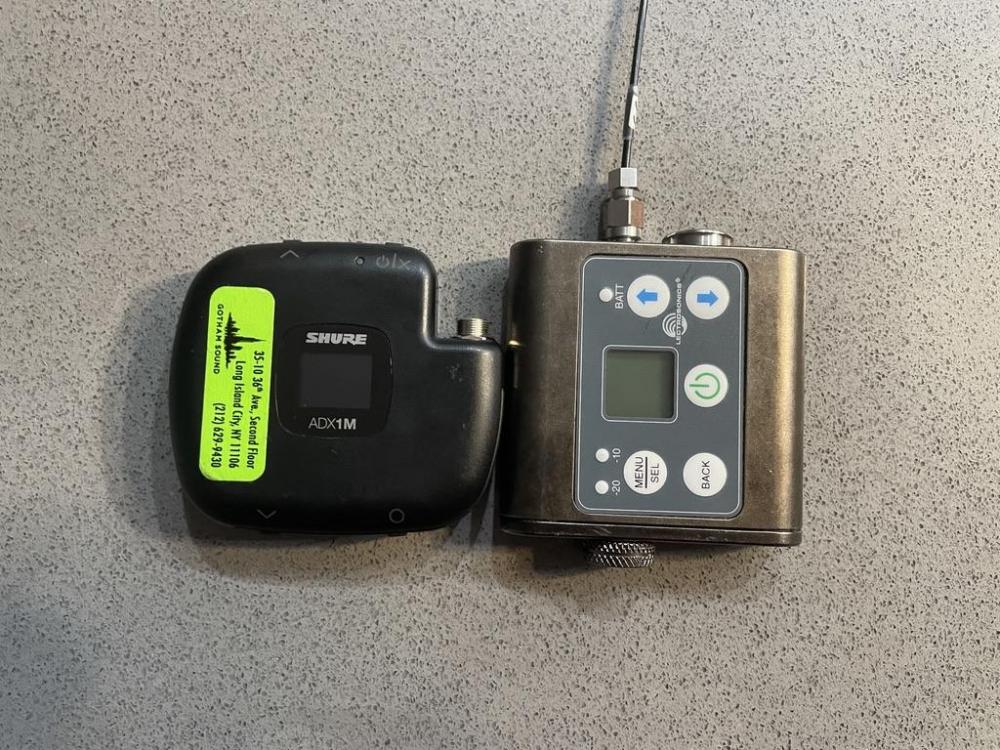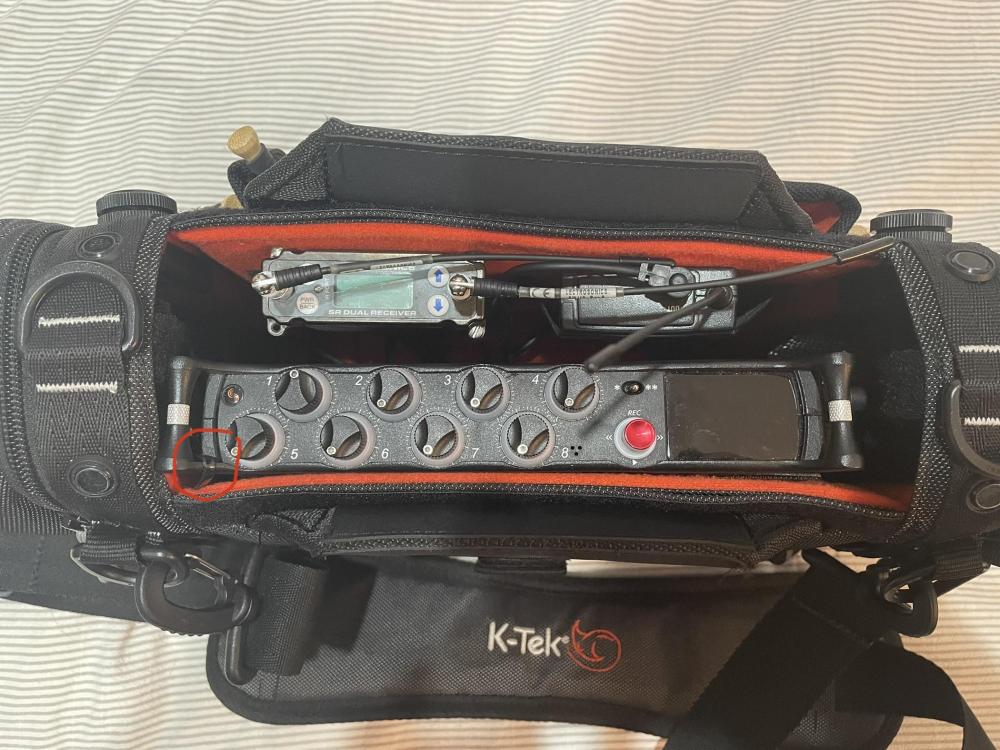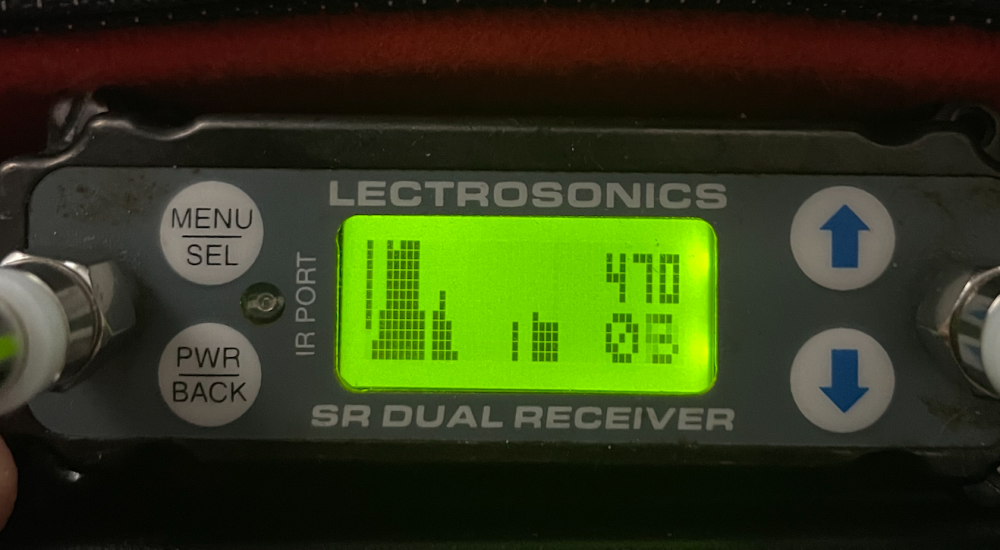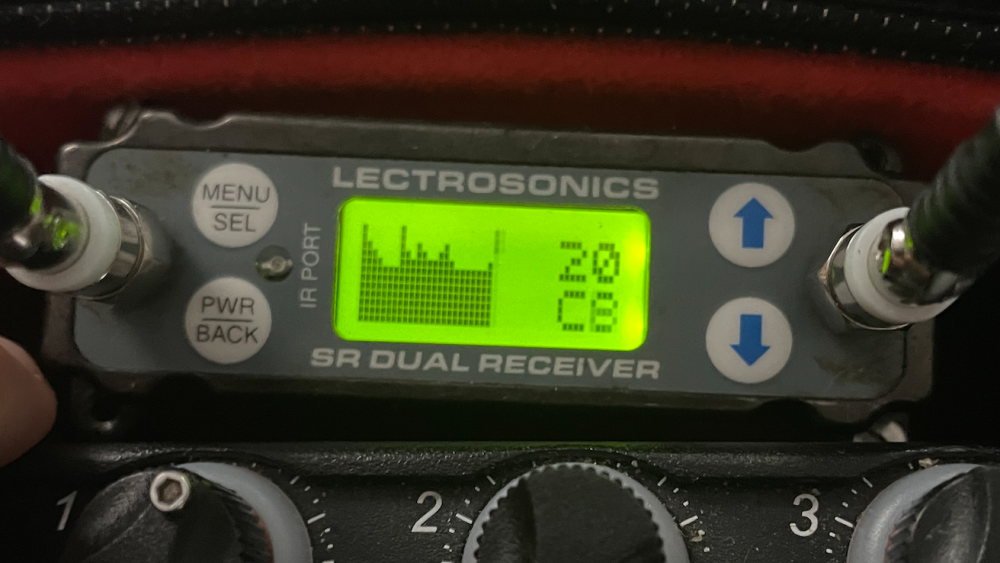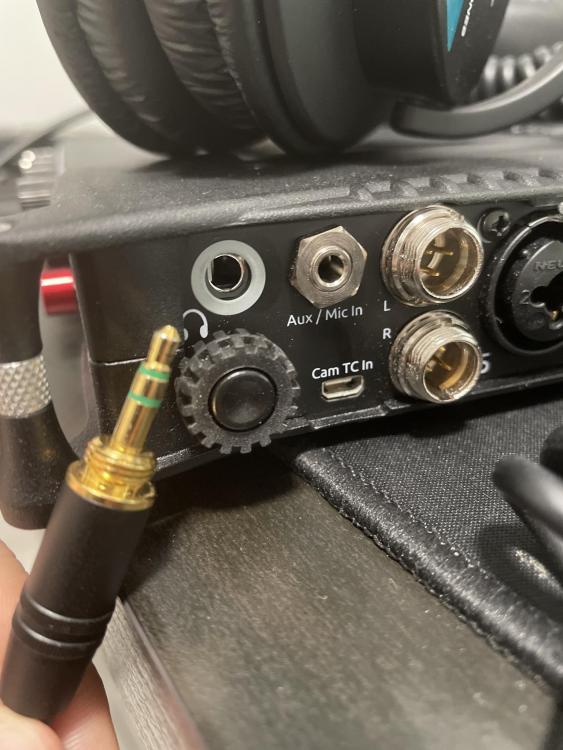-
Posts
56 -
Joined
-
Last visited
-
Days Won
3
Content Type
Forums
Gallery
Store
Everything posted by Ian Berman
-

Tentacle Sync 'Track E' - New minirecorders with timecode
Ian Berman replied to pillepalle's topic in Equipment
Whoa! Huge! -

Tentacle Sync Track E vs Lectrosonics MTCR or PDR
Ian Berman replied to frankaudio's topic in Equipment
I bought two of these with a few intended use cases: - I recorded an F1 car several weeks ago, and had to rent a couple PDR's and 4062's for interior plant mics. Bringing over a tentacle to jam sync the PDR after every new location & power cycle was a pain. Track E's fit right in with my existing timecode workflow and I wouldn't have to physically jam sync anything. 32 bit is a great use case for situations like this with extreme dynamic range and where I can't be physically present (although the PDR at minimum gain with the -18db safety track worked just fine, too). - Plants with the 4097, as you mentioned before. Every now and then, I get put into a car bag drop scenario with a minimal amount of prep time, and this would be the easy solution. - Mounting a 4097 on a film camera during verité or experimental style shoots. A lot of the DP's I work with mainly shoot on 16mm cameras and love stealing shots between setups. I've learned to be on my toes and rarely miss something they've ran off for, but I imagine a nice camera mounted mic synced to my bag's timecode could give post another good option. - Handing them to friends who want to record dialogue for a no-budget personal project, if I am unavailable or if they're traveling. I already did this, and a friend with no background in audio or film produced excellent recordings by simply clipping the included lav mic to each subject's collar. A huge improvement over the usual H4n or NTG2 amateur solution, especially for two person interviews, and laypeople are comfortable with using the phone app without any instruction by me on how to set levels etc. Getting a synced multi-mic interview recording without a mixer or external timecode device is a huge plus. -
Reviving this thread because I have a similar gig coming up in a few weeks. Long lens, stealth street interview sort of thing. Talent will be rigged with a cos11, and I need another mic facing outwards to pick up conversations with passers-by. I bought a Rode Pin Mic and am considering also using a 4097 with a windkiller painted to match and sewn into the folds of the costume. Costume will be a robe type thing. Hairline mic is not an option, and handheld prop is likely not either. Wondering if I should be trying anything else (maybe a 4080 rather than 4097, but I don't own that already..). I am pushing for a prep day to try everything out, so hopefully I will be able to try a few things and report back on what worked best. Open to suggestions. Thanks!
- 13 replies
-
- Hidden mics
- Prank
-
(and 1 more)
Tagged with:
-
I just rented an ADX5D and 2x ADX1m system for a gig last weekend, comparing it primarily to my Lectro SRc/SMDWB system. Here are my thoughts: Basics: -- ADX1m is not much different in size from a SMDWB, aside from lacking an antenna. -- Range was about equal to the Lectro systems with both systems set to their "medium" tx power (50mw & 10mw). I ran a few tests at home using 2 channels each placed in different spots and they each performed about the same, every time. I was primarily testing in an indoor environment where I was going through walls as I went further away, and did not do a line of sight test or use shark fins. -- Wireless reliability on whips was about the same When using it on a doc style shoot this weekend, I noticed the odd signal drop at shorter ranges, when "signal strength" was still 2-3 dots. I have also noticed similar behavior on my Lectros. Not a major issue, but not really an upgrade, either. -- Battery life was about the same on SMDWB's using rechargable NiMH batteries and the ADX1m's (~6-6.5h). However, Lectros have the option of using Lithiums, which nearly doubles their runtime. -- The digital system obviously sounded a bit better, but Lectros are plenty sufficient for broadcast already. Neither supports phantom power for boom use. -- The ADX5D's power consumption is about double that of the SRc, at ~4.3W compared to the SRc's ~2.2W. Measured at ~16V using my Audioroot distro. -- I liked the OLED screen, color LED lights, and menus on the Shure system quite a lot. It's all very slick and definitely has a cool factor. They do take a bit of getting used to at first, and there are a lot of menus that most users probably won't ever have to use. In comparison, the Lectro menus are much simpler and thus can be faster to operate. -- In general the Lectro system seems more resilient to dust, both tx and rx, but only time can tell, really. ShowLink impressions: -- ShowLink seemed to have a usable range of about 30-40ft indoors. While I was testing range, I experienced a bug where settings were not applied to the transmitter and the SL signal graph was not updating on either device. Importantly, I never lost audio signal to the transmitter. Both the rx and tx simply stayed on the old frequency when I manually selected a new frequency on the ADX5d. This was my primary point of concern for a remote control system, but experiencing a software bug right away still made me nervous. -- I don't really know what I would use ShowLink for. It's primary usefulness for me seems to be to change frequencies, which I rarely do after my initial scan in the morning, even when running around NYC. The automatic interference detection system is nice, but not something I personally find that I'm lacking, especially on low channel count bag jobs. -- ShowLink lacks a control of tx output power, tx locking controls, or a real "sleep" mode which conserves battery. Sleep mode on Lectros is something I use most days and helps me keep a pair of rechargables going all day under tough outfits. Unfortunately on the Shure system, you will need to swap batteries every 6 hours, period. I'm hopeful that this functionality can be added in a software update. Unanswered questions: -- Gain staging was rather confusing since there is no gain adjustment on the transmitter. I ended up cranking the output level on the receiver, which can go quite high, before feeding it into my MixPre10 at line level. I'm not sure whether the better approach would be to leave the ADX5D's output gain at 0db and gain up on the MixPre, rather than gaining up on the receiver and going in at roughly the same level as my SRc outputs at +6. The Shure receiver had several dozen db's of gain on the receiver side, which seemed clean enough to me. -- Some options on the ADX5D were a bit unclear. For example, they split up the receiver's options menu into 3 groups -- general settings (as the manual states, settings which apply to both channels), ch 1 and ch2, (settings for individual channels). However, when you do a group scan on one channel, and one channel switches to a different group, it presumably must also set a new frequency on the other channel in order to match the group. So then why is a group scan under the individual channel menus and not the general menu? Things like this would probably become more clear with repeated use. Conclusions: For me, the Axient digital system looks and feels extremely high tech, and has some killer features like dual transmit and interference detection, which I can see being useful in contexts I don't often find myself in. For the sort of low channel count (<6) bag work that I do, it has some rather basic drawbacks. Namely, a remote tx sleep option & significantly higher rx power consumption. But mainly, the ADX1m isn't much more versatile than the SMDWB, and there are significantly fewer options in the Shure wireless ecosystem (no SM, no SSM...). It also costs significantly more, has either the same or far worse battery life, and you need to buy the Shure proprietary batteries and charger, adding to the cost and space taken by the system. HOWEVER, if you're working with high channel count wireless systems & using a mixer which can support AES input, Axient digital starts to look a heck of a lot more appealing, especially if you have a sound utility to manage things like battery swaps & ShowLink access points. I can understand why these things are used so much on a stage or in a stadium, and I can imagine they're great for things like reality, too. I would be curious to hear anyone else's impressions of using the Axient system in the field, particularly for bag work, and if I missed something important or got anything incorrectly!
-
Interesting to hear you say that. I had the same takeaway, and it's not the first time I've thought this about a Hans Zimmer film. Dunkirk particularly comes to mind -- I felt that a lot of the visuals and tension building would have been more resonant by using less score rather than the constant, extremely loud tick-tick-tick score gluing each scene together. For whatever reason, I didn't have the same complaint about Blade Runner 2049; the music kind of melded with the atmosphere at points and the movie's pacing felt much slower to me. I'm surprised there weren't more scenes like this in Dune. I will say I LOVED the larger-than-life drum fill which was the main theme I think -- I was really wowed when it played during the intro montage of the film, and I believe it also played during the credits. What I don't really have patience for is the constant, overpowering use of score during every scene throughout the movie. It's probably effective for most audiences to keep tension high and emotions flowing. For me, perhaps influenced by being a location & post sound person, I very much believe in the use of quieter, longer scenes, lengthy takes, the use of atmosphere and layered ambiences to build emotion rather than being so heavily reliant on score. Many of my favorite films have very minimal scores. In other words, I'm one of the curmudgeons who comes out of every big-budget sci-fi movie wishing it was a little more like 2001... My takeaway of the film is completely different than most of the reviews I read on letterboxd, for instance, which often seem to joke about the movie being a bunch of "slow" scenes of spaceships taking off and landing. I didn't find anything in the movie slow. I thought it was so completely, thoroughly stuffed with short scenes, fast edits, constant score; it felt overflowing with things, very much contrasting with the ascetic production design & sets. It made me wish the book had been split into a trilogy so more scenes, and the sound, had room to breathe. Mark Mangini & Rob Bartlett are obviously legends, and I had no complaints with the actual sfx of the movie. I'm still watching the video you linked -- their discussion of the sound design of "the voice" is really awesome, especially in reference to worldizing and de-syncing the sub bass channel, adjusting atmospheres, etc. Thanks for sharing. I particularly loved the use of reverbs throughout the movie in addition to the big-ticket effects. Lastly, I saw Dune in an IMAX laser projection theater in New York City and definitely wish I went to a Dolby theater. The soundsystem sounded fine to my ears, but it was far too loud in IMAX, and most of the surrounds seemed to just be coming from my left since I was sitting mid-left in the theater, but such is life. I know the loudness is part of the IMAX experience -- it's not for me. This video makes me want to watch it again in atmos.
-
Do you mean the windkiller product or the piece-a-fur as mentioned previously in the thread?
-
Has anyone compared the bubblebee windkiller to the rycote option? Which one do you prefer for outdoor use? https://www.bubblebeeindustries.com/products/windkiller-se-dpa-4097
-
Yes, looking forward to hearing your thoughts on the system and hopeful they will come out with a more compact and interoperable charging solution in the future. If Wisycom doesn't announce new transmitters in the next few months I will probably just go with the axient and deal with the charging stuff somehow.
-
I was pretty set on purchasing an ADX5D with a few ADX1/m transmitters in the next few months until I looked at the discussion about charging options in that facebook group linked above. Wow! I can't think of something so silly that is such a dealbreaker for me. I mainly do one-man, non-union run & gun and commercial work. I live in nyc and thus have to be able to take my full gear package with me on foot. The idea that I would have to lug around two different types of proprietary chargers, the SBC240 and an SBC210, for slightly different sized proprietary batteries is comically unusable for my style of work. And the fact that I would have to spend nearly 2 grand on both of them + backups is a very tough pill to swallow. I suppose I can leave the chargers at home for day jobs and just carry a bunch of extra batteries, but it is a lot of money for the chargers when nearly every other tx just uses AA's. It's quite odd that they don't have a portable charger to go along with the ADX1M and ADX5D!
-
AFAIK, realtime audio is primarily single-threaded and the m1 is currently the fastest single thread chip on the market. Couple that with increased graphics performance and hardware encode/decode engines for h264/265 & prores and these machines appear to be very well positioned for a/v professionals like many people on this board. Not even to mention the SD card reader, 1000-nit screen w/ mini-LEDs, battery life, surround mixing suite for logic, etc. I'm super curious what "support for high impedance headphones" will pan out to exactly. And how loud these machines get under sustained use. If my computer can stay quiet while recording, and drive high-impedance headphones on the go, those are two huge things for audio people! I believe there's a version of pro tools which runs video fine under rosetta, a couple minor versions ago. But it's pretty insane avid can't even make the latest updates work under rosetta, much less native. One of the reasons I use reaper when I can... What exactly is memory bandwidth used for?
-
Ha! Never knew that.
-
That makes sense, I was just feeding it tc onto an audio track anyway so I'm assuming it would be pretty easy to just not use it if it was wrong. But that's good to know that high framerates are done with record run, and that I should just stick to the base project frame rate, for the future!
-
Update, I zip tied one corner of the mixpre 10 to the frame of my ktek bag (it's internally accessible without going thru any zippers). Seems to help with making the bag more rigid, and it no longer sags against my body in the same way.
-
Hi everyone, I’m wondering what you all do when camera switches from a standard frame rate (for me, usually 23.98 or 24) to a high framerate shot. I encountered this the other day, where we were shooting 23.98 on an FX9 most of the day, but grabbed some B-roll (with dialogue) in 120fps on a Sony a7s. I offered to switch timecode to 30fps across my tentacles, one of which was running audio tc into the a7s, the other was feeding my mixpre10. I figured this may be useful since 120 is divisible by 30. But the director said no, keep it at 23.98, as switching tc would create interpolation issues in post. Obviously we still slated etc. but I’m wondering if switching to a timecode divisible by high fps shots is a standard practice, or if you usually keep the timecode consistent throughout a shoot? thanks!
-
Adding on a bit to what's already been posted: using NiMH batteries in any transmitter I've used will usually result in a readout that says it's almost out of battery from the get-go, as you have noticed, due to their lower operating voltage. However, NiMH batteries hold this voltage for nearly the duration of their runtime, presenting a challenge to accurately measure how much capacity they have left. Whereas with alkaline (and I believe lithium too), you know their operating voltage, as it decreases, indicates a % use. This is why Lectro recommends using their built-in timer function, rather than displaying the tx's battery indicator, when you pop in fresh NiMH batteries. With fresh eneloop pro's I also get about 12h on my UWP-D11 and Sennheiser G3 -- about half that on my SMDWB's.
-
Reviving this thread, because I've been encountering some issues with my SRc A1 v1.20 and SMDWB's lately. I was on a job recently where manual scans appeared almost completely clean across the spectrum, but rx #2 was giving me a very similar buzzing noise to the quoted file. I had to swap that lav out entirely for a G3 at the last minute, because a new scan & clean frequency didn't solve the issue. May be related / not related: sometimes I do smart tune scans and get very bizarre results from the scan for rx1 vs rx2, as if the noise floor went up across the whole spectrum within a matter of seconds. These are in locations where I would expect to see hardly any RF energy at all. I'm unable to reproduce the issue reliably. I also often have a G3 A or UWP-D11 470 in my bag. Sometimes I use them as an extra receiver, but usually as a hop transmitter, sometimes one of each. Depends on the situation. I thought the issues were caused by using them as a hop transmitter, but as I said, sometimes it's not a problem for the SRc. Nonetheless, I am considering replacing the hop transmitter with a higher band unit and running a coax antenna cable onto my bag strap. Not sure what else I can do. I will keep trying to narrow down the issue, but in the meantime, I'm curious if anyone else has heard the buzzing/whining sound in the quoted post, or had unreliable scanning performance like the attached photos, and if you've been able to identify the issue.
-
Yeah, the sagging away from body thing happens to me with my MP10 and Stingray Junior X. I just velcro the MP10 to the bottom side of the bag directly, and don't use the velcro loops, since they're fastened in the middle of the bag, not the bottom. I have my wireless receivers at the top side of the main compartment so hanging the MP10 in the middle of the compartment would be odd. The MP10 mostly sticks to the bag in the middle area but doesn't quite hold onto the velcro on the sides, as it curves outwards against my body. It's a little annoying, but it's still very securely held by the velcro. If anyone has an idea of how to improve the rigidity of the bag (to keep it rectangular rather than bending out against my body), it would solve a minor annoyance... FWIW I've found that having both wireless pouches filled at the top side of the bag helps with rigidity for whatever reason, so even if I only need one or two wires I keep an extra receiver up there, rather than having an SRc on one side or the other and taking the other one out to save weight.
-
If you need a wireless hop and a timecode generator, though, it might make sense. Seems like it would take up less space than the G3 and tentacle sync e that I currently put on the camera, plus it wouldn't eat up spectrum from talent's wireless. However the fact that it uses a rechargeable battery kind of kills that idea -- on long shoot days you'd need to buy extra units and swap them out instead of just change AA's.
-

New Recorder - Zoom F6 vs Sound Devices MixPre‑6 II
Ian Berman replied to Rustic River's topic in Equipment
I owned a $40 talentcell battery for my F4 and it powered it all day with multiple phantom powered mics, no problem. I believe Curtis Judd mentions it in one of his videos, and many others reference it online, too. I have since upgraded to a MixPre 10t with an inspired energy 98wh battery and BDS, and IMO anything less than that is a bit of a half measure (I cannot speak for a USB c battery with the MP6 but you can always tape down the connector if you're worried about it). If your use case stays the same, the Zoom and Talentcell will do a perfectly sufficient job at significantly less cost, and to me seems like the far better value. The only issue is that if you want more complex setups in the future for different types of gigs, your kit is a bit less versatile. As others have mentioned, I would not stress about the difference in sound quality between the F6 and MP6. I have not personally compared the automixer on both devices, but I have watched Judd's video, which appeared pretty comprehensive... If you think the Zoom automixer function is not sufficient for your work, only you can make that decision -

Microphones for field recording - urban, nature & birds
Ian Berman replied to dellos's topic in Equipment
My 2c -- I do dialogue recording & urban ambience recording for films & ads in New York City. I own a Rode NTG3 and would not really consider using it on its own for recording urban ambiences and soundscapes here in New York. (I have not used more expensive shotgun microphones for this purpose so I can't really comment on them) To my ear, for recording individual sound sources, the NTG3 is OK if it's a quiet environment. And it can sometimes complement a stereo recording well. But as I said, I do not like to use it most of the time. I've attached an example of what an urban soundscape sounds like on the NTG3 vs a pair of LOM mikrousi omni mics -- I happened to record a soundscape with both of them this past Saturday morning in the East Village. Take a listen and decide for yourself! Generally speaking, I would try to rent equipment first and decide which microphone polarity and recording setup you find most pleasing. Or at least find comparison recordings online. Some of the most common ones are (cardiod) XY, ORTF; (omni) spaced pair; (shotgun/fig8) M/S; etc etc.. Each one requires different mics and will provide more or less pleasing results in different environments. There is also the possibility of just getting a Sony D100. And as others have mentioned, excellent wind protection is just as important as a good microphone. ambience_NYC_microusi.wav ambience_NYC_NTG3.wav -
Just stumbled across this topic. I recently had the same thing happen to me, almost exactly. 2 weeks after purchasing a pre 10t ii, barely even used, that part fell off. No damage to headphone jack on my mdr7506’s. SD said it wasn’t under warranty at first and eventually acquiesced after a few emails back and forth. see my topic here: https://jwsoundgroup.net/index.php?/topic/37180-mixpre-10t-headphone-jack-replacement/&tab=comments#comment-381472 Gotham sound ended up ordering the replacement part and fixing it for free, with a quicker turnaround than shipping it back to SD — but I certainly hope that this does not happen again!
-
I did contact SD, they offered to fix it if I shipped it back to them, but 2 weeks + cost of insured shipping makes me think I should get it done locally or try to DIY if it's simple. I live in New York and can get it repaired at Gotham Sound or another repair house. Sent over the same photos to them and waiting on a quote. It may be PC mount based on these photos, but I'm not really sure. Attached is the only resource I can find online for a look at the internals: Internal-Photos-3635481.pdf
-
Hi everyone, I just bought the mixpre 10t ii last week, and on my first shoot (which got canceled before it even began, no less) I somehow managed to shear off the exterior of the headphone connector. No idea how this happened, and my headphone's 1/8" jack is not bent or damaged either. See the attached photos. SD offered to fix it, but I won't have a recorder for 2 weeks and would have to pay for inbound shipping. They alternatively offered to send me a replacement part, but were specific in not being able to offer guidance on how to DIY the repair, which is understandable. Rather than take it to a reseller for repair and spend ~$75-150, I was wondering how simple this would be to DIY. I'm honestly not too great at soldering, but I've made simple circuits with arduinos and the like before, and I've built a couple desktop computers. Wondering if anyone here has experience with a repair like this and can offer guidance, as I don't see many resources online. Thanks!

.png.279748a58a2b862b7aa5f3b84126e232.png)


